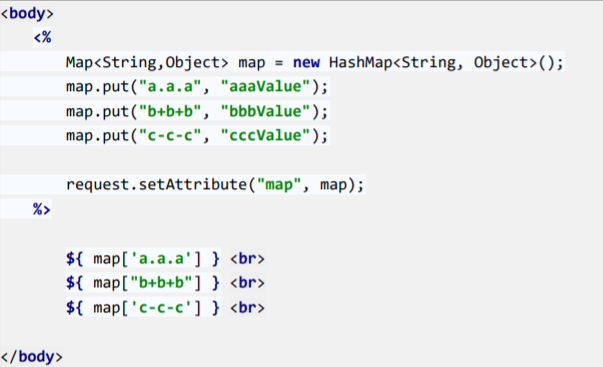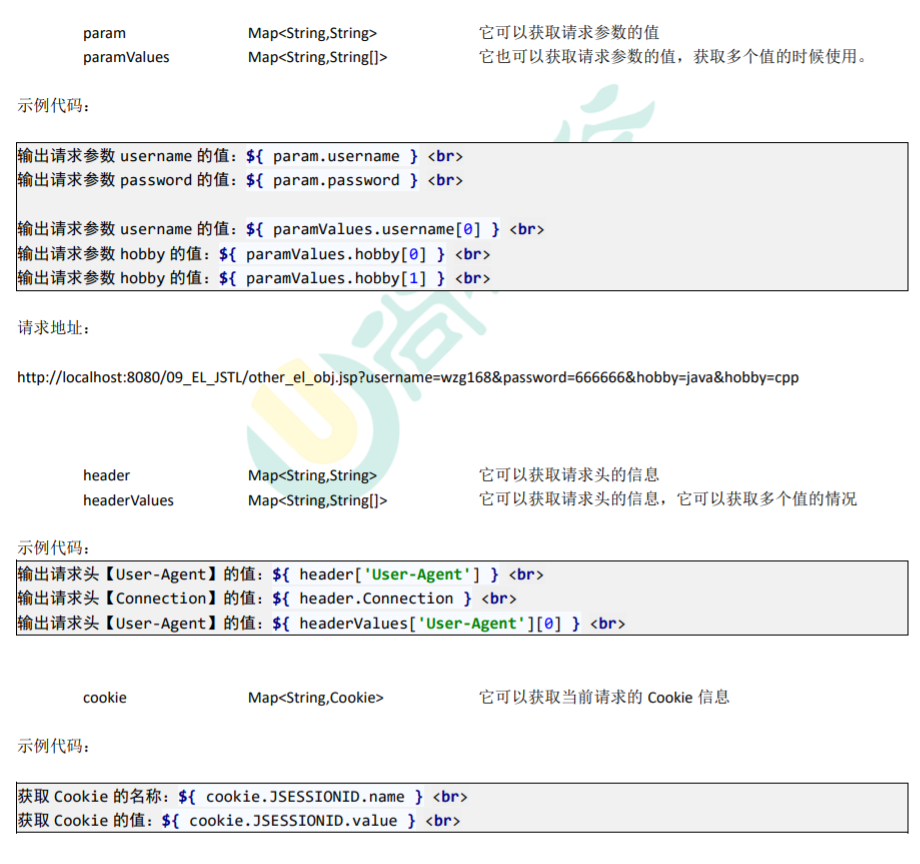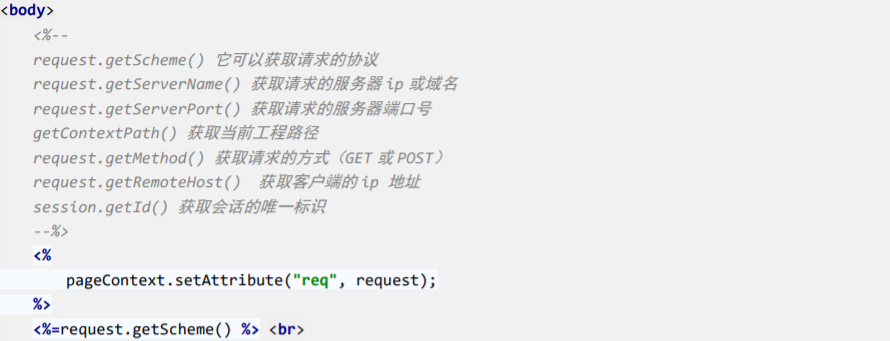EL表达式
什么是EL表达式,EL表达式的作用?
EL表达式的全称是:Exception Language。是表达式语言。
EL表达式的作用:EL表达式主要代替jsp页面中的表达式脚本在jsp页面中进行数据的输出。
因为EL表达式在输出数据的时候,要比jsp的表达式脚本要简洁很多。
<body><%request.setAttribute("key", "值");%>表达式脚本输出key的值是:<%=request.getAttribute("key1")==null ? "" : request.getAttribute("key1")%><br>EL表达式输出key的是:${key1}</body>
EL表达式的格式是:${表达式}
EL表达式在输出null值的时候,输出的是空串。jsp表达式脚本输出null的时候,输出的是null字符串。
EL表达式搜索域数据的顺序
EL表达式主要是在jsp页面中输出数据。
主要是输出域对象中的数据。
当四个域中都有相同的key的数据的时候,EL表达式会按照四个域的从小到大的顺序去进行搜索,找到就输出。
<body>
<%
// 往四个域中都保存了相同的key的数据。
pageContext.setAttribute("key","pageContext");
request.setAttribute("key","request");
session.setAttribute("key","session");
application.setAttribute("key","application");
%>
${key}
</body>
jsp四个域在使用的时候,优先顺序分别是,他们从小到大的范围的顺序。
pageContext ===>>> request ===>>> session ===>>> application
EL表达式输出Bean的普通属性,数组属性,List集合属性,Map集合属性
需求——输出Person类中普通属性,数组属性。List集合属性和Map集合属性。
Person类
public class Person {
private String name;
private String[] phones;
private List<String> cities;
private Map<String, Object> map;
public int getAge() {
return 19;
}
}
输出的代码
<body>
<%
Person person = new Person();
person.setName("张三");
person.setPhones(new String[]{"14124141", "132141"});
List<String> cities = new ArrayList<>();
cities.add("上海");
cities.add("上海c");
cities.add("上");
cities.add("海");
person.setCities(cities);
Map<String,Object> map = new HashMap<>();
map.put("key1","value1");
map.put("key2","value2");
map.put("key3","value3");
person.setMap(map);
pageContext.setAttribute("person",person);
%>
输出的Person:${person}<br>
输出的Person的name属性:${person.name}<br>
输出的Person的phones数组属性:${person.phones[0]}<br>
输出的Person的List集合中的元素值:${person.cities}<br>
输出的Person的List集合中个别元素值:${person.cities[1]}<br>
输出的Person的Map集合:${person.map}<br>
输出的Person的Map集合中某个key的值:${person.map.key1}<br>
输出的Person的age属性:${person.age}<br>
</body>
EL表达式——运算
语法:${运算表达式},EL表达式支持如下运算符:
关系运算

逻辑运算

算术运算
empty运算
empty运算可以判断一个数据是否为空,如果为空,则输出true,不为空输出false。
以下集中情况为空:
- 值为null值的时候,为空
- 值为空串的时候,为空
- 值是Object类型数组,长度为0的时候
- List集合,元素个数为0
- Map集合,元素个数为0
三元运算
${ 12 != 12 ? “真” : “假”}
“.”点运算和[]中括号运算符
.运算符,可以输出Bean对象中某个属性的值。
[]中括号运算,可以输出有序集合中某个元素的值。
并且[]中括号运算,还可以输出map集合中key里含有特殊字符的key的值。
EL表达式的11个隐含对象
EL表达式中11个隐含对象,是ELb表达式中自己定义的,可以直接使用。
| 变量 | 类型 | 作用 |
|---|---|---|
| pageContext | PageContextImpl | 它可以获取jsp中的九大内置对象 |
| pageScope | Map |
它可以获取pageContext域中的数据 |
| requestScope | Map |
它可以获取Request域中的数据 |
| sessionScope | Map |
它可以获取session域中的数据 |
| applicationScope | Map |
它可以获取ServletContext域中的数据 |
| param | Map |
它可以获取请求参数的值 |
| paramValues | Map |
它也可以获取请求参数的值,获取多个值的时候使用。 |
| header | Map |
它可以获取请求头的信息 |
| headerValues | Map |
它可以获取请求头的信息,它可以获取多个值的情况 |
| cookie | Map |
它可以获取当前请求的 Cookie 信息 |
| initParam | Map |
它可以获取在 web.xml 中配置的上下文参数 |
EL获取四个特定域中的属性
| 对象 | 对应的域 |
|---|---|
| pageScope | pageContext域 |
| requestScope | Request域 |
| sessionScope | Session域 |
| applicationScope | ServletContext域 |

pageContext对象的使用
- 协议
- 服务器ip
- 服务器端口
- 获取工程路径
- 获取请求方法
- 获取客户端ip地址
- 获取会话的id编号
EL表达式其他隐含对象的使用

JSTL标签库(次重点)
JSTL标签库全程是指 JSP Standard Tag Library (JSP标准标签库)。是一个不断完善的开放源代码的jsp标签库。
EL表达式主要是为了替换JSP中的表达式脚本,而标签库则是为了替换代码脚本。这样使得整个jsp页面变得更加简洁。
JSTL由五个不同功能的标签库组成。
| 功能范围 | URI | 前缀 |
|---|---|---|
| 核心标签库—重点 | http://java.sun/jsp/jstl/core | c |
| 格式化 | http://java.sun/jsp/jstl/fmt | fmt |
| 函数 | http://java.sun/jsp/jstl/functions | fn |
| 数据库(不使用) | http://java.sun/jsp/jstl/sql | sql |
| XML(不使用) | http://java.sun/jsp/hstl/xml | x |
在jsp标签库中使用taglib指令引入标签库
- Core标签库
- xml标签库
- FMT标签库
- SQL标签库
- FUNCTIONS标签库
<%--Core标签库--%>
<%@ taglib prefix="c" uri="http://java.sun/jsp/jstl/core"%>
<%--xml标签库--%>
<%@ taglib prefix="x" uri="http://java.sun/jsp/jstl/xml"%>
<%--FMT标签库--%>
<%@ taglib prefix="fmt" uri="http://java.sun/jsp/jstl/fml"%>
<%--SQL标签库--%>
<%@ taglib prefix="sql" uri="http://java.sun/jsp/jstl/sql"%>
<%--FUNCTIONS标签库--%>
<%@ taglib prefix="fn" uri="http://java.sun/jsp/jstl/functions"%>
JSTL 标签库的使用步骤
- 先导入jstl标签库的jar包
- taglibs-standard-impl-1.2.1.jar
- taglibs-standard-spec-1.2.1.jar
- 第二步,使用taglib指令引入标签库。
<%@ taglib prefix=”c” uri=”http://java.sun/jsp/jstl/core“%>
Core核心库使用
<c:set/>(很少使用)
作用:set标签可以往域中保存数据
<%--
作用:set标签可以往域中保存数据
域对象.setAttribute(key,value);
scope属性设置保存到哪个域
page表示PageContext域(默认值)
request表示Request域
session表示Session域
application表示ServletContext域
var属性设置key是多少
value属性设置值是多少
--%>
保存之前:${pageScope.abc}<br>
<c:set scope="page" var="abc" value="cssfs"/>
保存之后:${pageScope.abc}<br>
<c:if/>
if标签用来做if判断。
<%--
<c:if/>
if标签用来做if判断。
test属性表示判断的条件(使用EL表达式输出)
--%>
<c:if test="${ 12 == 12}">
<h1>12==12</h1>
</c:if>
<c:if test="${ 12 != 12}">
<h1>12!=12</h1>
</c:if>
<c:choose><c:when><c:otherwise>标签
作用:多路判断。跟switch…case…default非常接近
<%--
<c:choose><c:when><c:otherwise>标签
作用:多路判断。跟switch...case...default非常接近
choose标签开始选择判断
when表示每一种判断情况
test表示当前判断情况的值
otherwise表示其他情况
<c:choose><c:when><c:otherwise>变迁使用时需要注意的点:
1. 标签里不能使用html注释,要使用jsp注释
2. when标签的父标签一定要使用choose标签
--%>
<%
request.setAttribute("height", 150);
%>
<c:choose>
<c:when test="${ requestScope.height > 190}">
<h2>小巨人</h2>
</c:when>
<c:when test="${ requestScope.height > 180}">
<h2>很高</h2>
</c:when>
<c:when test="${ requestScope.height > 170}">
<h2>还可以</h2>
</c:when>
<c:otherwise>
<c:choose>
<c:when test="${ requestScope.height > 160}">
<h2>大于160</h2>
</c:when>
<c:when test="${ requestScope.height > 150}">
<h2>大于150</h2>
</c:when>
<c:when test="${ requestScope.height > 140}">
<h2>大于140</h2>
</c:when>
</c:choose>
</c:otherwise>
</c:choose>
<c:forEach/>
作用:遍历输出使用
- 遍历1到10输出
<%--
1. 遍历1到10输出
begin属性设置开始的索引
end属性设置结束的缩影
var属性表示遍历的变量(也是当前正在遍历到的数据)
for(int i = 1; i < 10; i++)
--%>
<table border="1">
<c:forEach begin="1" end="10" var="i">
<tr>
<td>第${i}行</td>
</tr>
</c:forEach>
</table>
- 遍历Object数组
<%--
2. 遍历Object数组
for(Object object:objects)
items表示遍历的数据源(遍历的集合)
var表示当前遍历到的数据
--%>
<%
request.setAttribute("arr", new String[]{"12431414", "15151651", "1515616"});
%>
<c:forEach items="${requestScope.arr}" var="item">
${ item }<br>
</c:forEach>
- 遍历Map集合
<%--
3.遍历Map集合
--%>
<%
Map<String, Object> map = new HashMap<>();
map.put("key1", "value1");
map.put("key2", "value2");
map.put("key3", "value3");
for (Map.Entry<String, Object> entry : map.entrySet()) {
}
request.setAttribute("map", map);
%>
<c:forEach items="${requestScope.map}" var="entry">
${entry} ${entry.key} --- ${entry.value}<br>
</c:forEach>
- 遍历List集合—-list中存放Student类,有属性:编号,用户名,密码,年龄,电话信息。
StudentBean
public class Student {
private Integer id;
private String username;
private String password;
private Integer age;
private String phone;
jsp
<%--
4. 遍历List集合---list中存放Student类,有属性:编号,用户名,密码,年龄,电话信息。
--%>
<%
List<Student> studentList = new ArrayList<>();
for (int i = 1; i <= 10; i++) {
studentList.add(new Student(i, "username" + i, "password" + i, 15 + i, "145151phone" + i));
}
request.setAttribute("studentList", studentList);
%>
<table border="1">
<thead>
<tr>
<td>编号</td>
<td>姓名</td>
<td>密码</td>
<td>年龄</td>
<td>电话</td>
<td>操作</td>
</tr>
</thead>
<tbody>
<%--
items表示遍历的集合
var表示遍历到的数据
begin表示遍历的开始索引值
end表示结束的索引值
step属性表示遍历的步长值
varStatus 属性表示当前遍历到的数据的状态
for(int i = 0; i < 10; i+=2) {
}
--%>
<c:forEach begin="0" end="7" items="${requestScope.studentList}" var="student">
<%--${student}<br>--%>
<tr>
<td>${student.id}</td>
<td>${student.username}</td>
<td>${student.password}</td>
<td>${student.age}</td>
<td>${student.phone}</td>
<td>修改、删除</td>
</tr>
</c:forEach>
</tbody>
</table>






